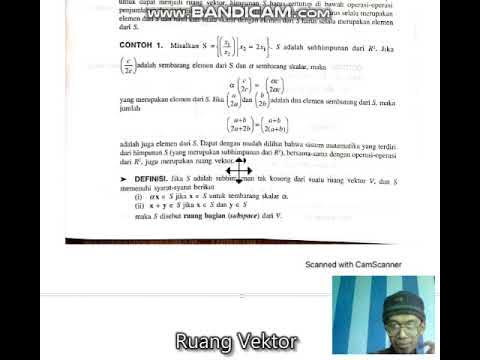Linear Algebra - Distance,Hyperplanes and Halfspaces,Eigenvalues,Eigenvectors ( Continued 3 )
Summary
TLDRThis lecture concludes a series on linear algebra for data science, focusing on the relationships between eigenvectors and fundamental subspaces. The instructor explains the significance of symmetric matrices, highlighting that they always have real eigenvalues and linearly independent eigenvectors. These concepts are crucial in data science, particularly for covariance matrices and algorithms like principal component analysis (PCA). The lecture connects eigenvectors to null space and column space, providing foundational knowledge for further study in regression analysis and machine learning.
Takeaways
- 🧮 Symmetric matrices are frequently used in data science, especially in algorithms and covariance matrices.
- 🔢 The eigenvalues of symmetric matrices are always real, and the corresponding eigenvectors are also real.
- ♻️ For symmetric matrices, we are guaranteed to have n linearly independent eigenvectors, even if some eigenvalues are repeated.
- 🔗 Eigenvectors corresponding to zero eigenvalues are found in the null space of the matrix, while those corresponding to non-zero eigenvalues span the column space.
- 🚫 If a matrix is full rank (none of the eigenvalues are zero), there will be no vectors in the null space.
- 🧩 The eigenvectors of symmetric matrices that correspond to non-zero eigenvalues form a basis for the column space.
- 📐 The connection between eigenvectors, null space, and column space is important for data science algorithms like principal component analysis (PCA).
- 🔍 Eigenvectors of symmetric matrices are linear combinations of the matrix's columns.
- 📊 Symmetric matrices of the form A^T A or A A^T are frequently encountered in data science computations and always have non-negative eigenvalues.
- 📚 The lecture series covers essential linear algebra concepts for data science, laying the foundation for further topics in regression analysis and machine learning.
Q & A
What happens when a matrix is symmetric?
-When a matrix is symmetric, its eigenvalues are always real, and it guarantees that there are n linearly independent eigenvectors, even if eigenvalues are repeated.
Why are symmetric matrices important in data science?
-Symmetric matrices are important in data science because they frequently occur in computations, such as the covariance matrix, and they have useful properties like real eigenvalues and guaranteed linearly independent eigenvectors.
What is the significance of eigenvalues being real for symmetric matrices?
-For symmetric matrices, real eigenvalues imply that the corresponding eigenvectors are also real, making the matrix easier to work with in practical applications like data science and machine learning.
How are eigenvectors related to the null space when the eigenvalue is zero?
-Eigenvectors corresponding to eigenvalue zero are in the null space of the matrix. If an eigenvalue is zero, the corresponding eigenvector lies in the null space.
What is the connection between eigenvectors and the column space for symmetric matrices?
-For symmetric matrices, the eigenvectors corresponding to nonzero eigenvalues form a basis for the column space. This means that the column space can be described using these eigenvectors.
What role do repeated eigenvalues play in the context of eigenvectors?
-When eigenvalues are repeated, there may be fewer linearly independent eigenvectors for a general matrix. However, for symmetric matrices, even with repeated eigenvalues, there will still be n linearly independent eigenvectors.
How do a transpose A and A transpose matrices relate to symmetric matrices in data science?
-Both A transpose A and A A transpose are symmetric matrices, which frequently occur in data science computations, such as covariance matrices. Their symmetry guarantees real, non-negative eigenvalues and linearly independent eigenvectors.
What does it mean if a matrix has no eigenvalues equal to zero?
-If a matrix has no eigenvalues equal to zero, it is full rank, meaning there are no vectors in the null space. This implies that all eigenvectors are outside the null space.
How are eigenvectors computed for a symmetric matrix with repeated eigenvalues?
-For a symmetric matrix with repeated eigenvalues, the eigenvectors can still be computed to be linearly independent, ensuring that the matrix has the full set of n independent eigenvectors.
What is the importance of the relationship between eigenvalues, null space, and column space in linear algebra?
-The relationship between eigenvalues, null space, and column space is critical in linear algebra because it helps define the structure of a matrix. Eigenvectors corresponding to zero eigenvalues belong to the null space, while eigenvectors corresponding to nonzero eigenvalues define the column space. These concepts are foundational in data science and machine learning algorithms like PCA.
Outlines

This section is available to paid users only. Please upgrade to access this part.
Upgrade NowMindmap

This section is available to paid users only. Please upgrade to access this part.
Upgrade NowKeywords

This section is available to paid users only. Please upgrade to access this part.
Upgrade NowHighlights

This section is available to paid users only. Please upgrade to access this part.
Upgrade NowTranscripts

This section is available to paid users only. Please upgrade to access this part.
Upgrade NowBrowse More Related Video
5.0 / 5 (0 votes)





